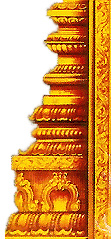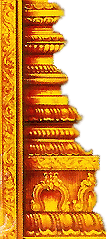The hills mentioned as Harikesava Parvatham and Varahagiri in the ancient Malaivagada book is presently called Kannivadi hill and Pandrimalai. Great Siddha Bogar, one among the 18 Siddhas, came here with his disciples Gorakkar, Karuvurar, Kongan and others and performed pujas here and gave life to a stone spilling water from his hand-pot known as Kamandala with the power of his penance.
It so happened that Mother Earth did not approve this development, cursed Bogar and changed the virgin again into a stone. Bogar, having lost all his powers of his penance, became too old in age suddenly, came to the Kannivadi hills and began the penance again intensely at Thethupatti Rajakali Amman temple place. Mother Earth appeared before Bogar pleased with his penance, relieved him from Her curse. Bogar then proceeded to Shaktigiri (now Palani) and worshipped Lord Muruga who graced Bogar with total relief from the curse. Bogar, with his 18 disciples wanted to make an idol of Lord Muruga other than that of a stone and decided to make it from Navapashanas (herbals) and made the Dandayuthapani idol.
Rajakaliamman: We are familiar with the story of Kannaki who burnt Madurai city to revenge the Pandya king for the injustice done to her husband Kovalan. After the death of Pandiyan, Kannaki came to the streets not knowing what to do next. The Madurai City deity appeared before her, told her of the effects of fate that led to these tragedies and also her story of previous birth. The fire came under control then.
According to a palm leaf note of Siddha Bogar, Madurai deity Kali entered the King’s palace and tried to take the sengol (ruling stick) when the king cried Oh! Meenakshi, Oh! Sokkanatha. Both appeared at the place.
There arose a debate between the Madurai Goddess and Sokkanatha. Lord Sokkanatha accused the Madurai Goddess that She failed in her duty to protect the city and the Pandya dynasty though she also belonged to that family. The Goddess replied that Kannaki was a human only till she entered the King’s place and became a Kali herself and therefore, she was not able to prevent Kannaki because of fate’s effects.
Sokkanathar said that Pandya had to be born many times again for the wrongs committed by him and he would build a Kali temple in his final birth and cross the curses. The Lord also told the Goddess that she would not have a temple for Herself till then but would have a shelter to sleep in the West Tower area. Accordingly, it is believed that Kali is there formlessly at the place where Maha Bogar performed penance. |





